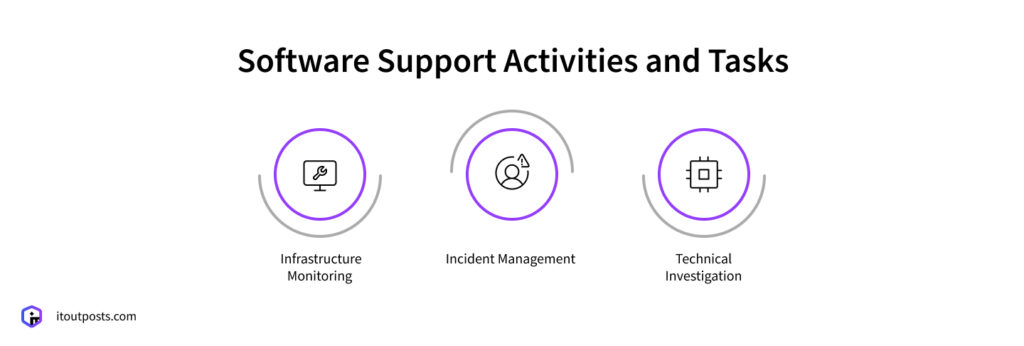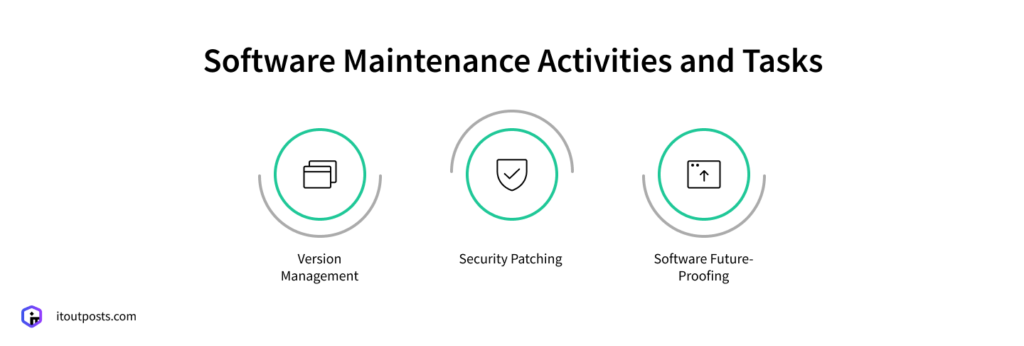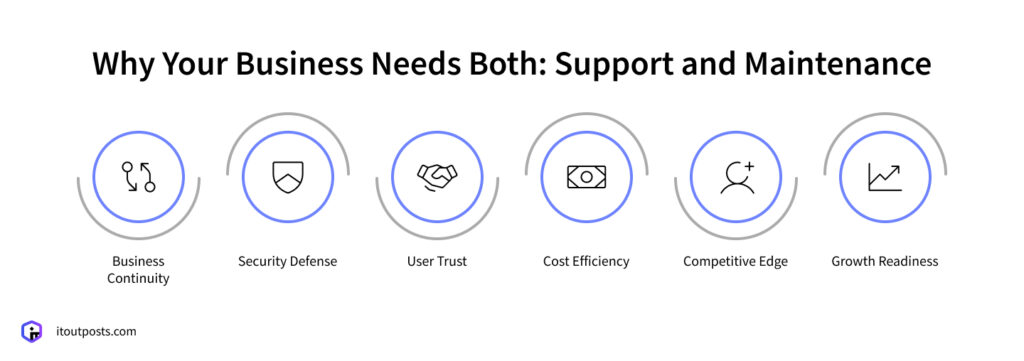Contents
Tech companies often pair “support” and “maintenance” in their service packages, creating confusion about what each service actually delivers.
Yet these terms are about two separate approaches to software health. One focuses on immediate problem-solving, the other on long-term system evolution. Let’s understand this distinction.
What Is Software Support?
Software support tackles the unexpected. Its main purpose is to respond quickly when users run into issues, performance drops, or systems crash.
Responding fast is important, but making sure the problem gets fixed properly is even more critical. Therefore, another goal of support experts is not just to cover up the symptoms but to investigate the root causes. That way, the same problems don’t keep happening to the same or other users.
Software Support Activities and Tasks
DevOps support teams are the ones on the front lines of ensuring your software runs smoothly. Here’s what keeps support teams busy (and sometimes up late at night).

24/7 Infrastructure Monitoring
Support specialists keep an eye on cloud resources, container health, and system performance in real-time. Usually, they use DevOps monitoring tools like Prometheus (a system that collects and stores performance metrics) and Grafana (turns this data into clear visual dashboards), which allow them to detect signs of trouble early. Whenever an issue occurs, support teams receive an alert and react accordingly, following established SLAs.
Incident Management
Even despite precautions, things can go wrong. And when they do, it is the support team’s responsibility to solve any infrastructure-related problems. Ideally, each kind of incident has its own step-by-step plan, or disaster recovery plan. It usually includes:
- Service backup procedures
- Disaster recovery procedures
- Steps for each critical disruption scenario
- Protocols for restoring the entire system
- Communication protocols (who gets notified when incidents occur)
Specialists evaluate how serious the issue is, follow a set of recovery steps, and cooperate with other teams if needed. One of the most important skills in these moments is knowing which issues to prioritize and staying calm under pressure when everyone else is feeling stressed.
Technical Investigation
One of the key ideas in DevOps is learning from mistakes to prevent them in the future. As the saying goes, “Never let a good incident go to waste.” This approach is at the core of support work, and it’s often called continuous service improvement (CSI).
Support teams spend time researching logs and figuring out exactly what went wrong. Sometimes it’s straightforward. Other times, it’s like trying to solve a puzzle with some pieces missing, making it much trickier to piece everything together.
What Is Software Maintenance?
While support teams handle the daily issues, software maintenance is about other operations. Maintenance experts are responsible for the health and growth of your systems in the long run, preparing for what’s coming next.
Software Maintenance Activities and Tasks
So, what exactly do maintenance specialists focus on?

Version Management
Technology is constantly changing. It feels like every week, there’s a new version of a tool or framework released. When critical components need upgrades, maintenance teams take charge. They plan these transitions, test compatibility, and ensure smooth updates across your entire stack.
Security Patching
Hackers don’t sleep, and they always look for new ways to break into software. That’s how software companies respond — they release security patches to fix vulnerabilities.
Maintenance teams monitor these updates, decide which ones your systems require, and test each patch before they install it. Their goal is to get critical security fixes in place fast so your software stays safe from the latest threats.
Infrastructure Future-Proofing
Since maintenance is about thinking ahead, maintenance teams also stay on top of new tools and technologies that could improve your systems. Maybe there’s a new cloud service that could save costs, or a security feature that can detect threats faster than before.
The Difference Between Support and Maintenance
Now that we’ve discussed the definitions of support and maintenance separately, let’s sum up what sets these concepts apart:
- Time focus. Support lives in the now, fixing what’s broken today. Maintenance looks ahead, building for a better tomorrow. So, while support teams rush to solve urgent issues, maintenance teams plan systematic improvements.
- Work approach. Support teams have to think quickly and react fast since every minute counts when systems are down. Maintenance teams tend to take their time, planning thoroughly and testing new changes so everything gets done right.
- Goals and impact. Support aims to get things working again fast, measuring success by how fast issues are resolved and how happy users are. Maintenance focuses on preventing problems before they happen and making the systems better overall, with success measured by system stability and successful upgrades.
- Risk management. Support teams usually deal with known problems using proven solutions—they stick to what’s already tested. Maintenance teams are more willing to take chances, trying out new technologies and updates carefully, to find smarter, better ways to optimize software performance and make it more cost-effective for businesses.
Why Your Business Needs Both: Support and Maintenance
Here are the main reasons professional support and maintenance activities should never be overlooked:

- Business continuity. Downtime kills revenue. Every minute systems are down costs money and can hurt your reputation. When Amazon experienced a one-hour outage in 2018, its losses were estimated at $72 million to $99 million. When you have a support team to rely on, you’re able to restore critical functions quickly. Meanwhile, maintenance prevents failures by monitoring system health and upgrading weak points before they break.
- Security defense. Security is another big part. Cyberattacks cost companies significant money. And that doesn’t include the lost trust and damage to the company’s image. When you’ve got good support and maintenance in place, you can catch active threats and fix vulnerabilities before they turn into big problems. This way, your business stays safe while others end up in the headlines for data breaches.
- User trust. People tend to switch to competitors after just a few bad experiences. But if your systems run smoothly, users will be more likely to stay loyal. They may also recommend your business to others. Overall, this increases your customer lifetime value and cuts down on customer acquisition costs.
- Cost efficiency. Speaking of costs, prevention is always cheaper than emergency fixes. In our experience, regular maintenance costs two to three times less than emergency repairs. This way, you’ll be able to invest in improving your systems instead of just constantly reacting to problems.
- Competitive edge. When your systems are stable, you gain a clear edge over competitors who struggle with outages or outdated tech. Faster performance, better features, stronger security — these become your advantages.
- Growth readiness. As cliché as it might sound, growth kills unprepared businesses. With proper support and maintenance, your business can grow smoothly. You can add new features without disrupting service and scale without falling apart.
Conclusion
Software is the heart of most business operations these days. Every decision you make with technology can have a direct impact on your bottom line.

I am an IT professional with over 10 years of experience. My career trajectory is closely tied to strategic business development, sales expansion, and the structuring of marketing strategies.
Throughout my journey, I have successfully executed and applied numerous strategic approaches that have driven business growth and fortified competitive positions. An integral part of my experience lies in effective business process management, which, in turn, facilitated the adept coordination of cross-functional teams and the attainment of remarkable outcomes.
I take pride in my contributions to the IT sector’s advancement and look forward to exchanging experiences and ideas with professionals who share my passion for innovation and success.